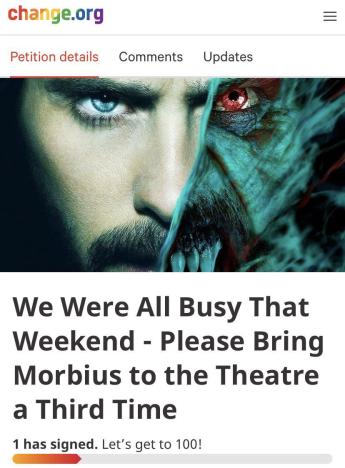It’s Morbin’ Time
Exhibit 004 - How the internet memed a flop back into theaters, and taught Hollywood absolutely nothing.
10/10/20252 min read


There’s something poetic about how Morbius failed twice. Not because it was a bad film (though it was), but because its resurrection revealed a fundamental misunderstanding between internet culture and corporate marketing. To the online world, Morbius became a playground for absurdity, a symbol of ironic devotion, like worshipping a false god just to watch the temple collapse. To Sony, that noise looked like potential profit.
The memes started harmlessly enough: people pretending Morbius was the greatest movie ever made, quoting “It’s Morbin’ Time” (a line that doesn’t actually exist in the film), and inventing fake records about its billion-dollar box office. But irony has gravity. It gathers momentum until it bends reality around it. Before long, even people who hadn’t seen the movie were participating in the joke. Half-sarcastic, half-sincere, all part of the performance.
Then came the punchline: Sony noticed the trend and decided to cash in. They assumed the memes meant people wanted more Morbius. They didn’t realize that being the butt of the joke doesn’t make you beloved, it makes you useful. When the film returned to theaters, it earned an embarrassing $85 per screen average. That kind of failure that feels almost metaphysical, like irony itself rejecting monetization.
The Death of the Feedback Loop
The Morbius re-release wasn’t just a marketing misfire; it was the collapse of an old feedback loop. Studios used to rely on attention as a proxy for interest. But in the meme economy, attention no longer signals desire. It signals participation. People weren’t watching Morbius, they were performing Morbius. They were building a shared universe of absurdity where “Morbin’ Time” existed in the same mythic space as “Among Us,” “Skibidi Toilet,” and “We live in a society.”
What Sony failed to grasp is that irony has its own logic. Online, enthusiasm doesn’t mean endorsement. Engagement doesn’t mean investment. The more ridiculous something becomes, the more powerful it is as a cultural artifact, but that power doesn’t translate to ticket sales. It only feeds the meme.
The Morbius Principle
The Morbius phenomenon should’ve been a cautionary tale, but instead it became a case study in how corporations still haven’t learned to read the room. They see virality as opportunity, not entropy. They don’t understand that online love and online mockery share the same language. In the algorithmic age, there’s no distinction between irony and sincerity, only the holy metrics.
The Morbius Principle is simple: when irony becomes indistinguishable from hype, reality stops mattering. A bad film can trend, a fake line can define a brand, and a billion-dollar lie can loop endlessly through the collective consciousness. It’s not just marketing anymore. It’s mythmaking.
And like all myths, it doesn’t have to be real. It just has to be repeated enough until it takes on a life of its own.
Post-Credits Scene
In the end, Morbius was never about the movie. It was about us. The audience that turned boredom into ritual and irony into communion. We didn’t resurrect Morbius because we cared; we did it because we could. Because in an endless feed of chaos, creating meaning out of nothing feels like power.
That’s the real magic of the meme age: sincerity is optional, but participation is sacred. We no longer worship the hero; we worship the mythos around him. And sometimes, that noise echoes loud enough to bring a dead film back to life, if only to watch it die again, for the meme.
Filed under: Irony, Attention Economy, Corporate Delusion, Meme Necromancy
*From the archives of Doomscroll Supply, documenting the absurdities of a culture that can’t tell the difference between mockery and worship.
